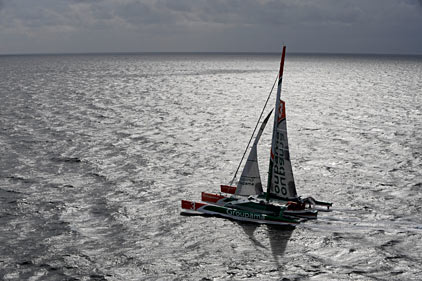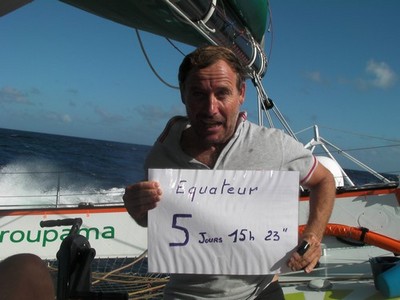
After eight days at sea, Groupama 3 is currently in a transition phase, which is causing her to lose part of her lead over the reference time in the Jules Verne Trophy. However, this passage across a ridge of high pressure is only set to last a little less than 24 hours and Franck Cammas and his crew are still managing an average speed in excess of 23 knots…
Getting around the Saint Helena High is always a key moment during the Jules Verne Trophy as it’s not easy to know, just a matter of hours away, how the gusts of hot Brazilian air will transform into a stormy depression system and head off towards South Africa. This is especially true when you have to set out from Ushant, nearly 5,000 miles away! In fact, the weather window heralding the start of this particular record attempt on 5th November, collectively chosen by the onshore weather router Sylvain Mondon from Météo France, Groupama 3’s navigator Stan Honey and in the final instance by skipper Franck Cammas, forecast a series of disturbances forming off Brazil. However, there is clearly a margin of error in knowing exactly where the point of impact will be. In reality, this margin of error has proved to be fairly slim since the encounter is due to take place from Saturday morning off Rio de Janeiro…
The counterpart to the Azores
However, in meteorological terms, Saint Helena is as renowned in the Southern hemisphere as the Azores is in the North Atlantic! Indeed year round, this austral isle and this northern archipelago are associated with anticyclones, which are relatively stable centres of activity involving high pressure. Situated in the inter-tropical zone, their positions vary relatively little from season to season, but they fluctuate with each day that passes according to the passage of depressions which push them along, compress them, shift them about and occasionally split them in two… However, the Azores High is more `volatile’ than its austral counterpart Saint Helena, which is due to the configuration of the terrestrial landmass which surrounds them, as well as the size of the ice cap covering the North and South poles.
Indeed, the differences in pressure are due to the thermal contrast, which marks the polar cold and the equatorial heat. As the Earth rotates around itself, it drags along its adjacent atmosphere and this movement, under the influence of the Coriolis force (diverting of a mass moving towards the right in the Northern hemisphere, and towards the left in the Southern hemisphere), causes a mixing of the hot and cold air masses. This helps to smooth the global temperature thanks to these thermal exchanges between the depressions and the anticyclones.
In this way, the Saint Helena High generates a tradewind system which rotates anticlockwise from this volcanic island which roughly marks its centre. The S’ly air flow along the coast of Africa (Namibia, Angola) turns towards the SE in the Gulf of Guinea and beneath the Doldrums, before rotating round to the E near Brazil, the NW level with the island of Trinidad and ultimately W in the Roaring Forties! This massive circulation thus forces the sailors coming from Europe bound for the Indies (or setting off around the world), to go right around the Western limit of this zone of high pressure, so as not to get caught up in the calm zones which reign at its centre.

Beneath the Southern Cross
This Friday lunchtime, Lionel Lemonchois indicated at the radio link-up that this short Brazilian detour wasn’t spoiling the atmosphere onboard in the slightest, as it only amounted to a few tens of miles lost, which were going to simply modify the manner in which they sail.
“We have discussions on a daily basis about what’s going to happen over the coming hours: in a nutshell, it’s already been three or four days that we’ve known how the weather conditions in the Southern Atlantic are going to pan out. As such we’re not surprised that we’re losing ground this Friday, even though we’re still sailing well this lunchtime. On a circumnavigation of the globe, you can’t make up ground everyday. There are transition phases like this one today, but the next stage is shaping up to be pretty good… We also have a little room for manoeuvre in relation to Orange 2! However, we’ll soon be getting out our boots and fleeces: we’re losing a little heat every night. At the moment, we’re carrying all the sail aloft with full mainsail, staysail and large gennaker. We’re slipping along nicely with fourteen knots of wind beneath a glorious sun. At night, the canopy of heaven is dotted with stars, while the Southern Cross is getting ever higher in the sky!”
Just minutes later, Groupama 3 was beginning to bend her trajectory southward, and then progressively SE, whilst still maintaining an average speed of over 22 knots. Clearly, in accounting terms, the overall performance figures are less flattering since this course 60° off the direct route since the latitude of Recife, has seen them lose ground: 380 miles VMG over 24 hours along the Jules Verne Trophy course, but still a daily total of 550 miles across the water! In short, the reduction in terms of bankable mileage is going unnoticed on board, it’s only in relation to Bruno Peyron’s course that there is some discrepancy. Indeed, it is worth noting here that Franck Cammas and his nine crew have been on a route which is virtually parallel to that of Orange 2 since crossing the equator; the latter of which was achieved nearly 5° further out to the West. Between now and Saturday lunchtime, the slow haemorrhage (30 mile deficit in 48 hours or a differential of 0.6 knots) will be totally cauterised by the powerful N’ly winds forecast…
Hanging a left…
In fact there has not been a hint of concern in the voices of the crew speaking at the radio link-up since setting out from Ushant: the atmosphere onboard is serene and concentrated, relaxed yet attentive. Groupama 3 hasn’t suffered and the crew have been able to rest in the current mild weather prior to the wintery climes of the Deep South … Indeed with the seas abating, pushed along by a moderate breeze on the beam, Franck Cammas and his men have scheduled in a complete check-up for the rig on Saturday morning, prior to the arrival of the Brazilian low. A torrid, bracing weekend is in store!
“We’re into a good rhythm because Groupama 3 is designed in such a way that we can rest. The days pass by quickly between sleep, a few odd jobs, a few hours at the helm and on watch, and contemplation of the sea. However, we’re not inundated with maintenance work… There’s just one line which is becoming a bit worn on the descent control for one of the foils. We’ve only had nice surprises so far: we’ve even had some real laughs! We’re lucky to be on a very fine boat… with a superb crew where there is mutual trust between us. For the time being, we’ve got some fairly good conditions for slipping along in. The Jules Verne Trophy is a marathon above all else: we’re going to have to keep it going over the long term and from this point of view, Franck (Cammas) has an approach which is very similar to that of Bruno Peyron, which involves a great deal of wisdom” concluded the winner of the Route du Rhum 2006.
The crew and organisation aboard Groupama 3
• Watch No.1: Franck Cammas / Loïc Le Mignon / Jacques Caraës
• Watch No.2: Stève Ravussin / Thomas Coville / Bruno Jeanjean
• Watch No.3: Fred Le Peutrec / Lionel Lemonchois / Ronan Le Goff
• Off watch navigator: Stan Honey goes up on deck for manoeuvres
• Each watch lasts three hours
• One watch system on deck, one watch on stand-by ready to help manoeuvre, one watch totally resting
The record to beat
Currently held by Bruno Peyron on Orange 2 since 2005 with a time of 50 days 16 hours 20 minutes at an average of 17.89 knots. Lionel Lemonchois, Ronan Le Goff and Jacques Caraës were aboard at the time.